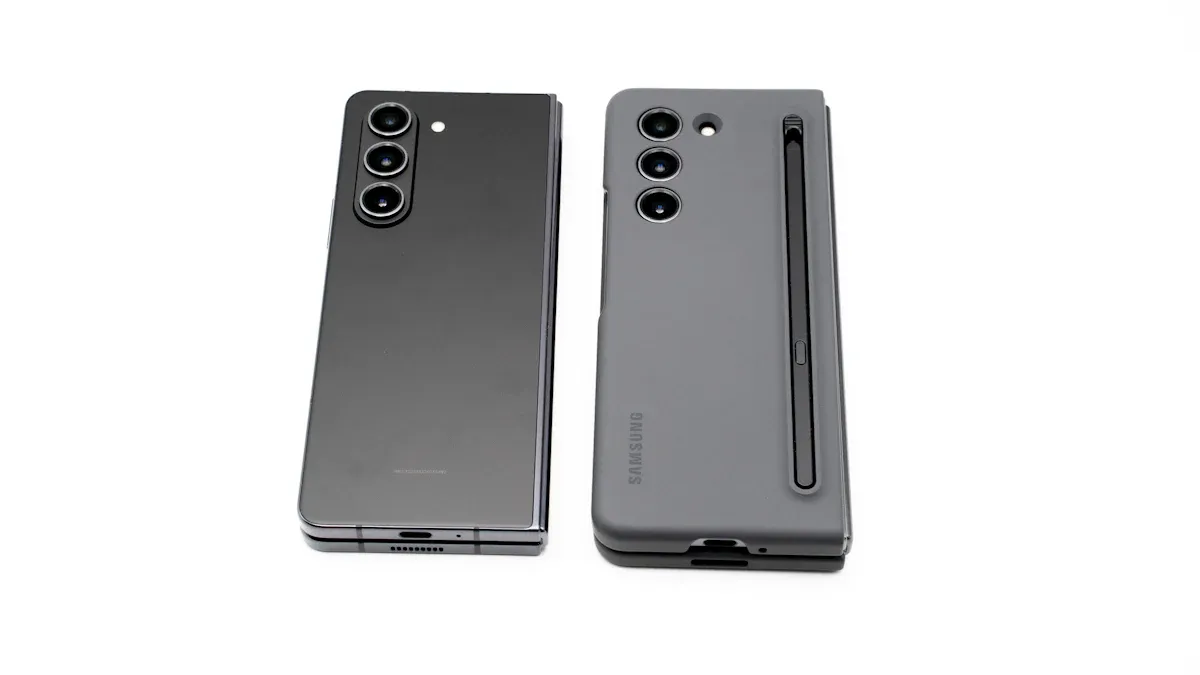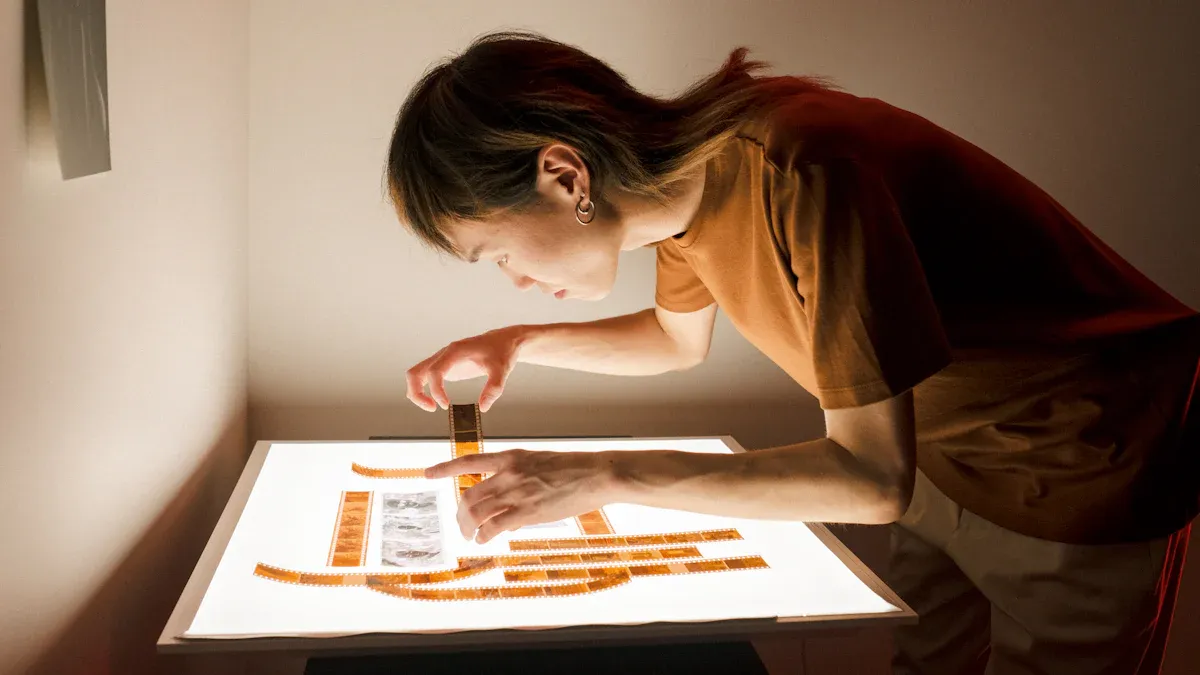Build vs. Buy a Film Lightbox

Are you unsure if you should build vs. buy a film lightbox? Your answer can depend on different factors. Some people care most about saving money, while others prioritize the best performance or easy maintenance. Here are the main considerations that can help you decide between build vs. buy:
Factor | Description |
|---|---|
Cost Considerations | The initial price and ongoing costs matter to many people when deciding to build vs. buy. |
Maintenance | Easy care can save you time and trouble, influencing your choice in the build vs. buy debate. |
Performance | Lamp density changes heat and energy use, which affects how well your lightbox performs, whether you build or buy. |
Artwork Compatibility | The type of film or art you display can alter your backlighting needs, impacting your build vs. buy decision. |
Energy Efficiency | Using fewer lamps can lower energy bills while maintaining good quality, a key point in the build vs. buy discussion. |
Think about what is most important to you before making your choice between build vs. buy.
Key Takeaways
Think about how much money you have. Making a lightbox costs about $50. Buying one usually starts at $100.
Look at your skills. If you know some DIY, you can build a lightbox. It can be fun and you can change it how you want.
Think about what you need. If you want a special size or look, building lets you make it your way.
Look at how to take care of it. DIY lightboxes often need less work than store-bought ones. Store-bought ones can break more easily.
Check the lighting. Make sure the light you pick has a high Color Rendering Index (CRI). This helps show colors the right way.
Build vs. Buy Overview

When you start thinking about the build vs. buy question for a film lightbox, you probably want to know what makes each option different. You might care about cost, how much time you spend, or how much you can change the design. Some people want a custom graphic or a jumbo lightboxes setup, while others just want something that works right away. Let’s break down the main differences so you can see which path fits your needs.
Pros
If you decide to build your own light box, you get a lot of control. You can pick the size, the type of lightbox, and even the power cord exit location. You can also choose the finish or paint color to match your space. Here’s a quick look at how customization compares:
Customization Aspect | Built-to-Order Lightbox | Commercial Product |
|---|---|---|
Power Cord Exit Location | Customizable | Pre-determined |
Finish/Paint Color | Custom options available | Limited to stock colors |
Size | Customizable | Fixed sizes |
You can also save money if you already have some materials at home. Many people say they built a lightbox for less than $20, while buying one can cost $50 or even more than $200. If you want to use your lightbox right away, building lets you skip the wait for shipping. You can start your project the same day you decide to build.
Here are some of the biggest advantages people mention when they build their own:
You can improve lighting quality with your own design, so you avoid vignetting and shadows.
You can use materials you already have, which saves money.
You can create your lightbox immediately and use it right away.
You can make the size fit your exact needs, whether you want a small box for slides or jumbo lightboxes for big graphics.
When you buy a commercial product, you get something that works out of the box. You don’t have to worry about wiring or assembly. Many commercial light boxes come with a warranty, so you have support if something goes wrong. You also get a professional finish, which can look great in a studio or office.
Cons
Building your own lightbox can sound easy, but there are some challenges. You might find that the cost goes up if you need to buy special parts like LED panels or wires. Sometimes, building can even cost more than buying, especially if you want a large size or a special type of lightbox. Here’s a table that shows the main cost differences:
Aspect | Building a Lightbox | Buying a Lightbox |
|---|---|---|
Initial Cost | ~$500 | ~$1500 and up |
Maintenance | Low (minimal upkeep) | High (more fragile) |
Content Creation Cost | Low (just a photo) | Higher (design time) |
You also need some electrical skills to put everything together. If you don’t have experience, the process can get complicated. Maintenance can be tricky, too. You have to store your DIY lightbox carefully and clean it without damaging the LED parts.
Here are some common drawbacks people talk about when they build their own:
You might spend more money than you expect if you need to buy all the parts.
Installing your own lightbox can be hard if you don’t know much about wiring.
You need to keep your lightbox in a safe place and clean it gently to avoid damage.
When you buy a lightbox, you lose some control over the design. You can’t always pick the exact size or graphic you want. Most commercial products come in fixed sizes and colors. If you want something unique, you might have to pay extra or wait longer for a custom order.
Tip: If you want a special design or need a unique size, building your own lightbox gives you more freedom. If you want something fast and easy, buying might be the better choice.
The build vs. buy decision depends on what matters most to you. If you want to save money, have fun with the design, and get the perfect size, building could be the way to go. If you want something simple and reliable, buying a commercial product might make more sense.
Light Box Cost & Quality
Price Comparison
When you look at the price of a light box, you might notice a big difference between building your own and buying one from a store. If you decide to build a light box at home, you can often keep your costs around $50, especially if you already have some tools or materials. But if you want to buy a commercial light box, you usually see prices starting at $100 and going up to $200 or more. The price can change based on the size you need and the features you want.
Here’s a quick look at what you might pay:
DIY light box: $50 (sometimes less if you have parts at home)
Commercial light box: $100–$200 for most standard sizes
Some retailers charge about $38.96 per square foot for backlit film prints, so a larger size can get expensive fast
If you want a big light box for large film or artwork, the cost can add up quickly. Smaller sizes are more affordable, but you still need to think about what fits your film best. When you build your own, you can pick the exact size you want without paying extra for custom work.
Tip: Always measure your film or artwork before you buy or build. Picking the right size saves you money and makes your project easier.
High CRI & Technology
When you use a light box for film, color accuracy matters a lot. You want your film to look true to life, so you need a light source with a high Color Rendering Index (CRI). CRI tells you how well a light shows colors compared to natural sunlight. For film work, experts recommend a minimum CRI value of 82. This level helps you see the real colors in your film, which is important for scanning or viewing.
Minimum CRI Value | Source |
|---|---|
82 | California's Title 20 legislation |
You can find high CRI lights in both DIY and commercial light boxes. Many LED strips and panels now offer CRI values above 82, so you can get good results even if you build your own. Just make sure to check the CRI rating before you buy any lights.
There are also different types of lighting technology used in commercial film lightboxes. Here’s a table to help you see the options:
Type of Light Box | Description |
|---|---|
Backlit Movie Poster Frames | Lightbulbs cover the whole back panel, giving you even light and good brightness. |
LED Movie Poster Light Boxes | Use LED lights for better energy savings and longer life than old bulbs. |
Snap Frame Light Boxes | Let you change graphics quickly with a frame that opens and closes; can be backlit or edge lit. |
Outdoor Movie Poster Light Boxes | Made for outdoor use, usually backlit so you can see them in any weather. |
If you want to build your own, you can choose the type of lightbox that fits your film project. LEDs are a popular choice because they last a long time and use less power. You can also find LED panels in many sizes, so you can match the size of your film or artwork.
Note: Always check the CRI rating and the type of lighting before you buy. The right technology helps your film look its best.
Custom Light Box Frames
Customization
When you build your own lightbox, you get to choose every detail. You can pick the size that fits your film or artwork perfectly. Maybe you want a small box for slides or a large one for a backlit graphic. You decide how bright the light should be and where the power cord goes. This freedom lets you design a tool that matches your workflow.
Custom light box frames help you work faster and easier. If you scan film, you can design a frame that holds your negatives steady. This makes scanning quicker and more fun. For product photography, you can create a box that lights up every part of your subject. You get even lighting, so your photos look sharp and professional. A custom frame also lets you show off a graphic or backlit film in a way that stands out.
People often want special effects for their displays. Here’s a table of popular lightbox effects you can try:
Lightbox Effect | Description |
|---|---|
Simplelightbox | Shows image counter, arrows, and captions |
Fancybox | Adds advanced features for complex displays |
Shutter | Uses unique transitions |
Thickbox | Supports many media types |
Custom | Lets you design your own effect |
You can mix and match these effects to fit your needs. You might want a simple look for film scanning or a fancy effect for a backlit graphic.
Online Resources
You do not have to start from scratch. Many guides online show you how to build custom light box frames. You can find step-by-step lists and videos. Most guides suggest using a wooden box, a bright light source, and a film holder. Some people use poplar planks, poster frames, and strip lights. You just need basic tools like a saw and a drill.
Here’s a quick list to help you get started:
Gather materials: wood, poster frame, LED strip lights, and a film holder
Cut and assemble the frame to your chosen size
Add a light source with a high CRI (at least 95) and a color temperature around 5500 K
Most DIY builds cost less than $100, which saves you money compared to buying a commercial lightbox. The guides also explain how to measure image quality and make smart choices for your design. You learn what works best for your film or graphic project.
Tip: Take your time to read a few guides before you start. Each one gives you new ideas for your design and helps you avoid mistakes.
Decision Guide
Checklist
You want to make the right choice between build vs. buy. A simple checklist can help you see what matters most for your project. Ask yourself these questions before you decide:
How often will you change the graphic or display in your light box?
Do you need a small or large size? Will people view it up close or from far away?
Do you want to use special materials, like aluminum, for a modern look?
How much money do you want to spend?
Do you have the tools and skills to build a light box?
How much time can you spend on this project?
Do you want a custom design or are you happy with a standard product?
Will you use the light box for film, product photos, or something else?
Tip: If you plan to update your display often, a design that lets you swap graphics easily will save you time.
Flowchart
Still not sure? Use this flowchart to help you decide between build vs. buy. Just follow the arrows based on your answers.
Question | Yes | No |
|---|---|---|
Do you need a custom size or special features? | Build your own | Go to next question |
Do you want to spend less than $100? | Build your own | Go to next question |
Do you have tools and basic DIY skills? | Build your own | Buy a commercial light box |
Do you need it fast and ready to use? | Buy a commercial light box | Build your own |
You can use this guide to match your needs with the best option. If you want a unique light box for your film or photos, building might be the way to go. If you want something quick and easy, buying could be your best bet.
Examples

When Building Wins
You might want to build your own lightbox if you have a special project in mind. Imagine you want to display a backlit graphic for your art show. You need a unique size that stores do not sell. You can design the frame to fit your artwork perfectly. Maybe you want to scan film at home and need a type of lightbox that holds negatives steady. You can add a film holder and choose the right brightness for your needs.
Some people love jumbo lightboxes for big displays. You can design one to show off custom photo prints or transparent photo prints. You get to pick the color, the power cord spot, and even the way the graphic slides in and out. If you enjoy hands-on work, building lets you control every detail. You can use online guides to help with the design and make sure your jumbo lightboxes look just right.
Tip: Building works best when you want a custom design or need a size that stores do not offer.
When Buying Wins
Sometimes, buying a lightbox makes more sense. You might need something fast for a school project or a business event. You can order a ready-made lightbox and use it right away. Many commercial boxes have a clean design and come in standard sizes. You do not have to worry about wiring or tools.
If you want to display a graphic in your office or store, a commercial box gives you a professional look. Some people use these for advertising or to show off a backlit graphic. You can also find boxes made for outdoor use. These keep your graphic safe from rain and sun.
Note: Buying is a good choice if you want a simple setup, need a standard size, or do not have time to build.
There are many things to think about when you pick building or buying a film lightbox. Here is a simple table that shows the main ways they are different:
Aspect | Building a Lightbox | Buying a Lightbox |
|---|---|---|
Initial Cost | Lower | Higher |
Maintenance Cost | Lower | Higher |
Content Management | Simpler | More Complex |
Think about what is most important to you. You might care about saving energy, hiding cords, or using rechargeable batteries. Look at the checklist and flowchart above to help you choose. If you want more information, you can search for DIY guides or read reviews about commercial lightboxes.
FAQ
What tools do I need to build a film lightbox?
You need basic tools like a saw, screwdriver, and drill. You also need a ruler, glue, and a way to cut wood or plastic. Most people already have these at home.
Can I use any LED strip for my DIY lightbox?
No, not all LED strips work well. Look for LED strips with a high CRI (at least 82). High CRI helps your film colors look true and bright.
How long does it take to build a lightbox?
Most people finish a simple lightbox in a few hours. If you want a custom size or special features, you might spend a day or two. Planning helps you save time.
Is a commercial lightbox better for scanning film?
A commercial lightbox gives you even lighting and a professional look. If you want fast results and less setup, buying works best. DIY boxes can work well if you build them carefully.
Can I make a jumbo lightbox at home?
Yes! You can build a jumbo lightbox if you have the right materials and space. Just measure your film or artwork first. Bigger boxes need stronger frames and more lights.
See Also
Exploring Acrylic Light Box Photography Techniques And Tips
Comparing Frameless And Framed Acrylic LED Light Boxes
Extruded Or Cast Acrylic Light Boxes: Which Shines Brighter?

